|
|
|
Sort Order |
|
|
|
Items / Page
|
|
|
|
|
|
|
| Srl | Item |
| 1 |
ID:
191149
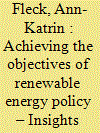

|
|
|
|
|
| Summary/Abstract |
Many countries choose policy objectives around their renewable energy expansion targets, such as efficiency and effectiveness. Due to the different nature and impact of those objectives, not all can be achieved simultaneously, so prioritising objectives is advisable. In this paper, we theoretically analyse the relationship between objectives and show that most European countries with renewable energy auctions in place have defined incoherent policy strategies in their respective renewable energy legislation. Based on these strategies, we analyse which objectives lead to the choice of which auction design elements conducting a qualitative comparative analysis. Considering 269 auction rounds from 20 European countries in the period 2011–2020, not all resulting choices of auction designs are in line with auction theory and existing literature’s findings on the relationship between objectives and auction design. Nevertheless, we show that on a country-level basis, most considered countries choose congruent auction designs, which either support all their (coherent) stated objectives or prioritise one or several of their incoherent objectives. For those countries with an incongruent auction design, we give recommendations on how to adapt their auction design depending on their exact choice of policy objectives.
|
|
|
|
|
|
|
|
|
|
|
|
|
|
|
|
| 2 |
ID:
144680


|
|
|
|
|
| Summary/Abstract |
This article addresses the question of how the Israeli government and the Jewish Agency for Israel (JAFI) handled the absorption of Ethiopian immigrants in the early 1990s. It shows that, reflecting the historic rivalry between the two organizations, their interaction lacked a clear division of roles and was mired by rivalry and conflicting interests. As a result, the individual immigrant, besides dealing with predictable absorption difficulties, had to cope with bureaucratic failures.
|
|
|
|
|
|
|
|
|
|
|
|
|
|
|
|
| 3 |
ID:
132646


|
|
|
|
|
| Publication |
2014.
|
| Summary/Abstract |
This article offers the first national examination of the determinants of adoption of wind and solar energy generation on U.S. farming operations. The inclusion of state policies and characteristics in a multilevel modeling approach distinguishes this study from past research utilizing logit models of technology adoption which focus only on the characteristics of the farm operation. Results suggest the propensity to adopt is higher for livestock operations, larger farms, operators with internet access, organic operations, and newer farmers. The results find state characteristics such as solar resources, per capita income levels, and predominantly democratic voting increasing the odds of farm adoption. This research suggests the relevance of state policy variables in explaining farm level outcomes is limited, although in combination best practice net metering and interconnection policies-policies designed to encourage the development of small scale distributed applications-are shown to increase the likelihood of farm solar and wind adoption. The prevalence of electric cooperatives-which are often not subject to state renewable energy policies and often service farms-is negatively related with the propensity to adopt and suggests that policy design may be a factor
|
|
|
|
|
|
|
|
|
|
|
|
|
|
|
|
| 4 |
ID:
094399
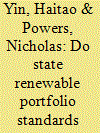

|
|
|
|
|
| Publication |
2010.
|
| Summary/Abstract |
Several US states have passed renewable portfolio standard (RPS) policies in order to encourage investment in renewable energy technologies. Existing research on their effectiveness has either employed a cross-sectional approach or has ignored heterogeneity among RPS policies. In this paper, we introduce a new measure for the stringency of an RPS that explicitly accounts for some RPS design features that may have a significant impact on the strength of an RPS. We also investigate the impacts of renewable portfolio standards on in-state renewable electricity development using panel data and our new measure of RPS stringency, and compare the results with those when alternative measures are used. Using our new measure, the results suggest that RPS policies have had a significant and positive effect on in-state renewable energy development, a finding which is masked when design differences among RPS policies are ignored. We also find that another important design feature - allowing "free trade" of REC's - can significantly weaken the impact of an RPS. These results should prove instructive to policy makers, whether considering the development of a federal-level RPS or the development or redesign of a state-level RPS.
|
|
|
|
|
|
|
|
|
|
|
|
|
|
|
|
| 5 |
ID:
136186
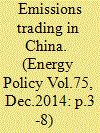

|
|
|
|
|
| Summary/Abstract |
China has implemented emissions trading schemes in seven cities and provinces, and is planning a national cap-and-trade scheme. The seven pilot schemes show marked differences in design and operate in very diverse economic circumstances. Challenges encountered in the pilot schemes include the risk of over-allocation of emissions permits, unpredictable underlying growth trends, robust measurement and verification procedures, and the interaction with regulation in the energy sector. In addition, experiences from developed countries’ emissions trading schemes, in particular the EU ETS, can help inform the decisions about the design of a future Chinese national scheme. We find that Chinese policymakers will need to pay particular attention to the operation of emissions trading in a heavily regulated electricity sector. Setting emission caps in the context of a national emissions intensity target creates specific difficulties. Related price developments are uncertain and depend largely on underlying emissions growth rates. The option of auctioning permits and using the proceeds for other purposes is not taken into consideration extensively. Finally, implementing reliable systems for monitoring, reporting and verification of emissions remains a major task. This paper serves as an introduction to the special issue “Emissions trading in China” and draws on insights from the papers in the special issue.
|
|
|
|
|
|
|
|
|
|
|
|
|
|
|
|
| 6 |
ID:
179739
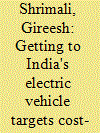

|
|
|
|
|
| Summary/Abstract |
In the context of India's ambitious electric vehicle targets, we examine two related questions. First, based on lifetime costs, which electric vehicles need to be subsidized? Second, based on lifetime subsidies, which subsidy option would be the most cost-effective? We find that electric two-wheelers, three-wheelers, four-wheeler-taxis, and buses do not need to be subsidized given that they are already cost competitive with comparable vehicles using internal combustion engines. We also find that personal cars and long-haul trucks need to be subsidized significantly, by one-third to one-half of the upfront costs. Finally, we find that an upfront subsidy is the most cost-effective subsidy option, followed by a per kilometer subsidy, which is effectively 19–31% costlier, whereas financing subsidies are found to be the least cost effective. Our results suggest that a cost-effective policy in India would be to subsidize only personal cars and long-haul trucks, while using the upfront subsidies.
|
|
|
|
|
|
|
|
|
|
|
|
|
|
|
|
| 7 |
ID:
168317
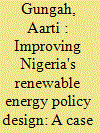

|
|
|
|
|
| Summary/Abstract |
Nigeria has embarked on various programmes and policies in trying to make its energy system efficient. Renewable energy (RE) is one at the heart of this reformation. However, the country's energy reforms within the ambit of RE suffer setbacks, owing to poorly utilized RE resources and initiation of relevant policies. Consequently, these setbacks widen the gap between energy demand and supply. This has motivated the need to appraise the effectiveness, efficiency, equity and institutional feasibility of Nigeria's RE legal and policy framework. The study adds to literature by adopting a case study approach to initiate improvement of the effectiveness and efficiency of the Nigerian RE legal and policy framework. Our results disclose an urgent need to drive a coordinated and consistent legal intervention, specific and time-bound targets, political commitment, policy choice and design, funded research and development activities, social awareness and public engagement, in order to improve RE development and deployment in Nigeria. Additionally, enacting well-conceived RE laws in Nigeria and building relevant institutions, were identified to be crucial in achieving expansive and sustainable RE development for the country.
|
|
|
|
|
|
|
|
|
|
|
|
|
|
|
|
| 8 |
ID:
136194
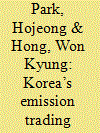

|
|
|
|
|
| Summary/Abstract |
In 2008, the government of Republic of Korea (Korea) announced the national abatement target aiming at 30% reductions from the Business-as-Usual projections by 2020. Accordingly, the Emission Trading Scheme (ETS) will be implemented from 2015 onwards. As ETS performance substantially depends on the structural design, it is critically important to examine the details of Korean ETS for the achievement of cost effectiveness and concurrent development of an active emission trading market. This paper addresses several policy design issues for this purpose. After providing an overview on the current framework of Korean ETS, we propose ways to achieve flexibility, consistency and market efficiency of the program in consideration of the preexisting policies. Issues in policy design are discussed by focusing on allowance allocation, market stabilization measures and price mechanism in the emission and energy markets in Korea. This paper will serve as a practical guideline for establishing sustainable and market-efficient Korean ETS that can be compatible with the international standards as in the EU ETS.
|
|
|
|
|
|
|
|
|
|
|
|
|
|
|
|
| 9 |
ID:
191279
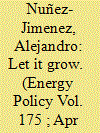

|
|
|
|
|
| Summary/Abstract |
Decarbonizing urban energy consumption is critical for addressing climate change, yet renewable power installations in cities are rare due to limited space and economic unattractiveness. Community solar, where multiple electricity users share the electricity generated by their rooftop PV systems, could help overcome these barriers and accelerate PV adoption in cities. Using an agent-based model, we simulated the decision-making of nearly 5000 building owners in a city district in Zurich, Switzerland, and assessed three locally relevant policy scenarios: no community solar, community solar with adjacent buildings, and community solar with buildings within a 100-meter radius. The results show that allowing community solar with adjacent buildings increases the installed PV capacity in 2035 by 1%, as greater economies of scale and higher self-consumption make PV adoption more economically attractive. A more permissive policy, allowing community solar with buildings within a 100-meter radius, provides more opportunities to communities to grow over time and results in 21% more PV installed capacity in 2035 than without community solar. These findings demonstrate the potential of community solar to accelerate PV adoption in cities and underscore the significant role of policy design in achieving this goal.
|
|
|
|
|
|
|
|
|
|
|
|
|
|
|
|
| 10 |
ID:
177312
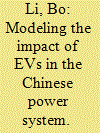

|
|
|
|
|
| Summary/Abstract |
The deployment of renewable electricity and electric vehicles (EVs) provides a synergistic opportunity to accelerate the decarbonization of both China's power and transportation sectors. Here, we evaluate the potential impacts of EVs by utilizing the SWITCH-China model designed to meet emissions constraints within its power sector while integrating the electrified transportation sector. We focus on how various EV stocks, and charging strategies (unmanaged versus smart charging) impact the power sector, in terms of generation and hourly grid operation, the capacity mix, and achieving the Paris Agreement goals. Large-scale deployment of EVs increases the need for generation capacity, while the implementation of smart charging requires 6.8%–14% less additional storage capacity. We calculate that power system integration costs to incorporate EVs range from $228 - $352 per EV. We show that a smart charging strategy saves between $43 and $123 per vehicle more annually in 2050 than a case with the same EV stock where the charging is unmanaged. Our results suggest that a 140 GW annual growth of renewables from 2020 to 2050, coupled with an aggressive EVs deployment using smart charging can put China solidly on a path to meet its ambitious carbon cap targets.
|
|
|
|
|
|
|
|
|
|
|
|
|
|
|
|
| 11 |
ID:
178810


|
|
|
|
|
| Summary/Abstract |
In recent years, the multifunctionality of farming activities and diversification of on-farm income sources have increasingly included renewable energy generation. The uptake of on-farm anaerobic digestion (AD), however, continues to lag behind other renewable energy activities. Moreover, on-farm AD is not only a source of renewable energy, but also a means of farm waste management and thus a means of enhancing environmental quality. This paper provides an in-depth analysis of the policy barriers that might explain this limited uptake, and identify key directions for future AD policy design. We draw on a mixed-methods research design, with data collected by questionnaires, interviews and a round-table workshop of stakeholders. We analyse our data using a framework that disaggregates ‘policy’ into meta, meso and micro levels of Policy Means and Policy Ends. We conclude that future policy must recognise the synergies between on-farm AD as a source of renewable energy and as a means of waste management, reflected in instrument mix and instrument calibration. Calibration-stability is also found to be of critical importance. We also offer new insights and understanding around the application of our chosen policy framework, notably how it can analyse policies that are nested within large, complex policy systems.
|
|
|
|
|
|
|
|
|
|
|
|
|
|
|
|
| 12 |
ID:
136190
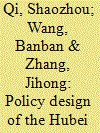

|
|
|
|
|
| Summary/Abstract |
Of seven pilot emissions trading schemes (ETS) being run in China, the ETS in Hubei province is the only provincial pilot in the central and western regions of the country with a high GDP growth rate and heavy industrial structure. As such, it is quite representative of China as a whole and its ETS will therefore be reasonably characteristic of a future nationwide market. This paper describes the policy design of the Hubei ETS, including aspects of coverage, cap, allowance allocation, transactions, compliance and penalties. Then, after making a comparison with the other Chinese pilots and emissions trading schemes in the European Union (EU) and California, the paper offers a summary of several distinct features of the Hubei ETS. First, the small numbers of entities that are covered by the scheme produce a considerable proportion of the emissions. This makes Hubei the world׳s third largest carbon market. Second, the Hubei ETS applies several mechanisms to deal with the province’s rapid growth rate. Third, the scheme׳s policy design emphasizes liquidity. In addition to these unique features, the Hubei ETS also shares some common features with all the pilots in China.
|
|
|
|
|
|
|
|
|
|
|
|
|
|
|
|
| 13 |
ID:
116443


|
|
|
|
|
| Publication |
2012.
|
| Summary/Abstract |
Policy makers and policy-oriented scholars concerned with development and reform commonly appeal to "political will" as a cornerstone of development. We question the circular and voluntaristic view of leadership behavior inherent in such an approach, and argue that-to be more useful for the analysis of development outcomes, as well as for policy design-the discourse on political will should be firmly integrated into a more systematic framework of analysis. In particular, we suggest that it should engage in more active dialogue with the combined insights offered by principal-agent theory and what we refer to as state theory. More specifically, in the framework we develop, the principal-agent framework offers the analytical tools for analyzing leadership behavior at the micro level, while state theory provides crucial insights regarding the macro-level factors shaping leadership behavior. In the end, these two perspectives in tandem have the potential to significantly increase our understanding of empirically observed leadership behavior as well as our theoretical understanding of how the context-and especially the character of underlying social contracts-shapes and constrains "political will."
|
|
|
|
|
|
|
|
|
|
|
|
|
|
|
|
| 14 |
ID:
137690


|
|
|
|
|
| Summary/Abstract |
This article considers the usefulness of low-carbon scenarios in public decision-making. They may be useful as a product-oriented trajectory. The scenarios on the agenda of the 2013 Energy Debate in France belong to this category. But a scenario may also be process-oriented, in the sense that its scripting process helps build consensus and a minimum level of agreement. We have scripted scenarios using a codevelopment method, involving about 40 stakeholders from the private and public sectors, and from the state: NGOs, consumer groups, trade unions, banks and local authorities. They selected policies they considered acceptable for achieving 75% greenhouse gases emission reductions in 2050. These policies were then integrated in the Imaclim-R-France technico-economic simulation model, as part of a high or moderate acceptability scenario. In the first case emissions were cut by between 58% and 72% by 2050; in the second case by between 68% and 81%, depending on the energy price assumptions. All these measures benefited jobs and economic growth, swiftly and durably cutting household spending on energy services. This offers a solid basis for gaining acceptability for low carbon trajectories; the process constitutes also a framework for consolidating collective learning centering on the acceptability of climate policies.
|
|
|
|
|
|
|
|
|
|
|
|
|
|
|
|
| 15 |
ID:
177148
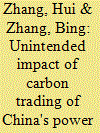

|
|
|
|
|
| Summary/Abstract |
Carbon trading is considered a strategy for reallocating carbon permits and reducing abatement costs that may also change energy consumption and the distribution of atmospheric pollution emissions, resulting in environmental health benefits or damage on a regional scale. In this research, we use an agent-based model to construct a national carbon emissions trading market of the power sector based on the year of 2013, and simulate the key atmospheric pollution emission patterns and the corresponding environmental health effects. We find that compared with a command and control policy, the carbon trading policy is able to reduce the CO2 emissions and save abatement costs by approximately 63.53 RMB/ton. Meanwhile, the results show the carbon trading policy would synergistically reduce PM2.5 emissions by 1.55 million tons. Addition, we use a simplified exposure-response model to estimate health benefits by synergistically reducing PM2.5 emissions, and find that the carbon trading policy would decrease 45,200 cases of all-cause mortality and generate 307.07 billion RMB in environmental health benefits. The co-benefit accounts for 0.52% of the nation's gross domestic product (GDP) in 2013. However, compared with the command and control policy, carbon trading changes the pollution emission distribution among the different provinces, and results in unintended environmental health damages in some provinces. Setting reasonable trading directions and exchange ratios, increasing stringency of environmental regulations in some provinces with worsening air pollution should be implemented to complement the carbon trading policy.
|
|
|
|
|
|
|
|
|
|
|
|
|
|
|
|
|
|
|
|
|